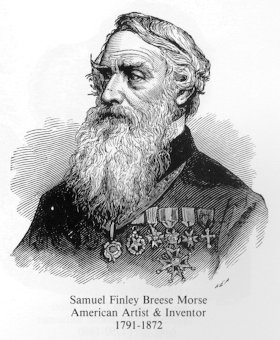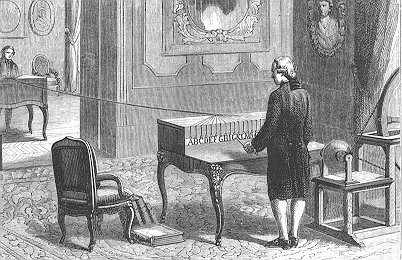Inventing the Telegraph
Today, we look at ninety years of electric telegraphy before Morse. The University of Houston's College of Engineering presents this series about the machines that make our civilization run, and the people whose ingenuity created them.
 Historians of technology are cautious about naming the first person to invent anything, because someone else has always thought up at least a part of it first. Great ideas always flow from more than one inventive mind, and the telegraph is no exception. The noted American painter Samuel F. B. Morse put together a telegraph system in 1837. But the most original part of that system was the code that bears his name.
Historians of technology are cautious about naming the first person to invent anything, because someone else has always thought up at least a part of it first. Great ideas always flow from more than one inventive mind, and the telegraph is no exception. The noted American painter Samuel F. B. Morse put together a telegraph system in 1837. But the most original part of that system was the code that bears his name.
The seed for the electric telegraph had been sown ninety years earlier. In 1747 an Englishman named William Watson showed how to send electrostatically-generated signals long distances through a wire, with the circuit completed through the earth. Seven years later an anonymous writer published an article in the Scots Magazine showing how to send messages with an array of twenty-six such wires (one for each letter of the alphabet.) Various multiple-wire systems were built in Switzerland, France, and Spain before 1800.
The idea of sending all the letters on a single wire, and using a code to distinguish them, was introduced about sixty years before Morse by the French inventor LeSage. Still, multiple-wire systems lingered for several more decades.
The whole business got a big boost with the invention of the storage battery. Battery power let people drive all kinds of output signals -- like magnets and marks on litmus paper. Between 1800 and Morse's work, many telegraph systems were developed, and many were not bad.
So how did Morse get all the credit? Well, for one thing, since he was American, he's the only telegraph inventor that American schools tell children about. British children learn about the earlier system of Cooke and Wheatstone. But two other things were also important: Morse's code was the one that caught on. And, although few features of Morse's system were unique, taken together they were the right arrangement for a commercial success.
Then, too, Morse was involved in a remarkable range of self-expressive activities -- art, invention, politics, photography -- the list goes on. He was combative, and he got into controversies in all those fields. When it came to fighting for telegraph patent priority, he was very effective. In 1854 he won a Supreme Court decision that gave him most of the telegraph royalties. (To his credit, he died a wealthy philanthropist.)
But the idea of the telegraph came from that anonymous writer in 1753, after Watson showed how to close a circuit through the ground. The person who can most nearly be called the inventor of the telegraph was someone having fun dreaming up a new idea. That says volumes about the nature of invention. We actually got the telegraph from an anonymous inventor whose only reward was knowing that he (or she) had given a great idea away to the world.
I'm John Lienhard, at the University of Houston, where we're interested in the way inventive minds work.
(Theme music)
Garratt, G. R. M., Telegraphy. A History of Technology, Vol. IV, c. 1750-1850. (C. Singer, E. J. Holmyard, A. R. Hall, and T. I. William's, eds.) New York: Oxford University Press, 1958, pp. 644-671.
This is a revised version of Episode 15.

Image of Lesage with his telegraph apparatus
(from Harper's Monthly, 1873)